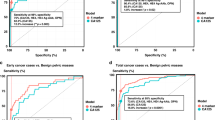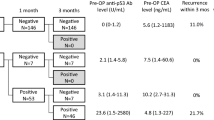Abstract
Purpose
To evaluate the use of p53-autoantibodies (p53-aab) for monitoring minimal disease after standard therapy of advanced epithelial ovarian cancer (EOC).
Methods
Retrospective analysis of p53-aab in preoperative and long-term follow-up serum samples from 10 patients selected for representing three relevant EOC subgroups: platinum-sensitive disease after macroscopic complete debulking (n = 4) and platinum-sensitive (n = 3) or platinum-resistant disease (n = 3), both after suboptimal debulking with residual tumor of <1 cm diameter. p53-aab levels were quantified by a sandwich ELISA in two independent experiments. CA-125 values of all samples and clinical information were retrieved from medical records.
Results
Patients with early relapse (median PFS 7 months, n = 8) had high p53-aab levels throughout follow-up while CA-125 values had dropped below the cut-off after primary surgery during or after chemotherapy in these cases. Patients with seroconversion to p53-aab negativity experienced prolonged PFS (n = 2; #1: 50 months, #2: no evidence of disease for 36 months until last follow-up). Continued p53-aab positivity was not related to the resection status or platinum sensitivity.
Conclusions
p53-autoantibodies may be a highly sensitive marker for minimal residual tumor mass after surgery and/or chemotherapy rather than standard CA-125, possibly due to the different nature of these markers. CA-125 released by cancer cells is related to tumor mass, whereas p53-aab levels can indicate the presence of few tumor cells due to amplification by the immune system. Seroconversion of p53-aab could be associated with long-term survival.

Similar content being viewed by others
References
Anderson KS, LaBaer J (2005) The sentinel within: exploiting the immune system for cancer biomarkers. J Proteome Res 4(4):1123–1133
Bauerschlag DO, Schem C, Weigel MT et al (2010) The role of p53 as a surrogate marker for chemotherapeutical responsiveness in ovarian cancer. J Cancer Res Clin Oncol 136(1):79–88
Burger RA, Brady MF, Bookman MA et al (2011) Incorporation of bevacizumab in the primary treatment of ovarian cancer. N Engl J Med 365(26):2473–2483
Cramer DW, Bast RC Jr, Berg CD et al (2011) Ovarian cancer biomarker performance in prostate, lung, colorectal, and ovarian cancer screening trial specimens. Cancer Prev Res (Phila) 4(3):365–374
Gadducci A, Ferdeghini M, Buttitta F et al (1998) Serum anti-p53 antibodies in the follow-up of patients with advanced ovarian carcinoma. Anticancer Res 18(5B):3763–3765
Gumus E, Erdamar S, Demirel G et al (2004) Association of positive serum anti-p53 antibodies with poor prognosis in bladder cancer patients. Int J Urol 11(12):1070–1077
Hori SS, Gambhir SS (2011) Mathematical model identifies blood biomarker-based early cancer detection strategies and limitations. Sci Transl Med 3(109):109ra116
Lu D, Kuhn E, Bristow RE et al (2011) Comparison of candidate serologic markers for type I and type II ovarian cancer. Gynecol Oncol 122(3):560–566
Lu H, Ladd J, Feng Z et al (2012) Evaluation of known oncoantibodies, HER2, p53, and cyclin B1, in prediagnostic breast cancer sera. Cancer Prev Res (Phila) 5(8):1036–1043
Mastropaolo W, Fernandez Z, Miller EL (1986) Pronounced increases in the concentration of an ovarian tumor marker, CA-125, in serum of a healthy subject during menstruation. Clin Chem 32(11):2110–2111
Mongia SK, Rawlins ML, Owen WE et al (2006) Performance characteristics of seven automated CA 125 assays. Am J Clin Pathol 125(6):921–927
Pedersen JW, Gentry-Maharaj A, Fourkala EO et al. (2012) Early detection of cancer in the general population: a blinded case–control study of p53 autoantibodies in colorectal cancer. Br J Cancer doi:10.1038/bjc.2012.517
Perren TJ, Swart AM, Pfisterer J et al (2011) A phase 3 trial of bevacizumab in ovarian cancer. N Engl J Med 365(26):2484–2496
Riedinger JM, Wafflart J, Ricolleau G et al (2006) CA 125 half-life and CA 125 nadir during induction chemotherapy are independent predictors of epithelial ovarian cancer outcome: results of a French multicentric study. Ann Oncol 17(8):1234–1238
Rohayem J, Conrad K, Zimmermann T et al (1999) Comparison of the diagnostic accuracy of three commercially available enzyme immunoassays for anti-p53 antibodies. Clin Chem 45(11):2014–2016
Soussi T (2000) p53 Antibodies in the sera of patients with various types of cancer: a review. Cancer Res 60(7):1777–1788
Takeda A, Shimada H, Nakajima K et al (2001) Monitoring of p53 autoantibodies after resection of colorectal cancer: relationship to operative curability. Eur J Surg 167(1):50–53
Tan HT, Low J, Lim SG et al (2009) Serum autoantibodies as biomarkers for early cancer detection. FEBS J 276(23):6880–6904
Vogl FD, Frey M, Kreienberg R et al (2000) Autoimmunity against p53 predicts invasive cancer with poor survival in patients with an ovarian mass. Br J Cancer 83(10):1338–1343
Zalcman G, Schlichtholz B, Tredaniel J et al (1998) Monitoring of p53 autoantibodies in lung cancer during therapy: relationship to response to treatment. Clin Cancer Res 4(6):1359–1366
Conflict of interest
MF is employed by Steinbeis-Transferzentrum commercializing the p53-AAB ELISA. The Steinbeis-Transferzentrum had no influence on data acquisition, analysis or interpretation and manuscript drafting. All other authors have no conflict of interest to disclose.
Author information
Authors and Affiliations
Corresponding author
Rights and permissions
About this article
Cite this article
Häfner, N., Nicolaus, K., Weiss, S. et al. p53-autoantibody may be more sensitive than CA-125 in monitoring microscopic and macroscopic residual disease after primary therapy for epithelial ovarian cancer. J Cancer Res Clin Oncol 139, 1207–1210 (2013). https://doi.org/10.1007/s00432-013-1432-2
Received:
Accepted:
Published:
Issue Date:
DOI: https://doi.org/10.1007/s00432-013-1432-2




